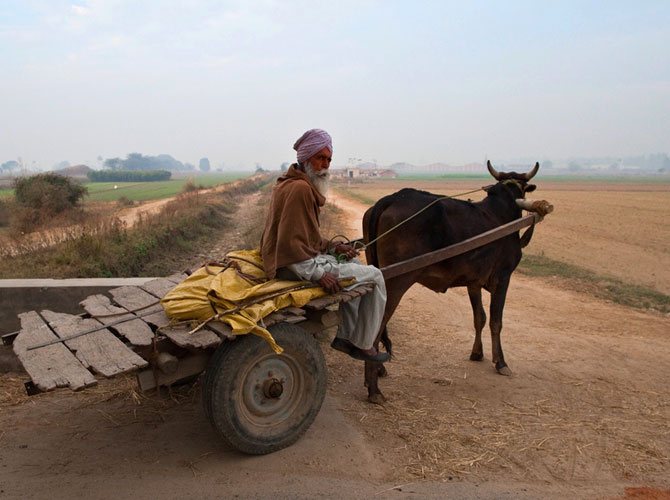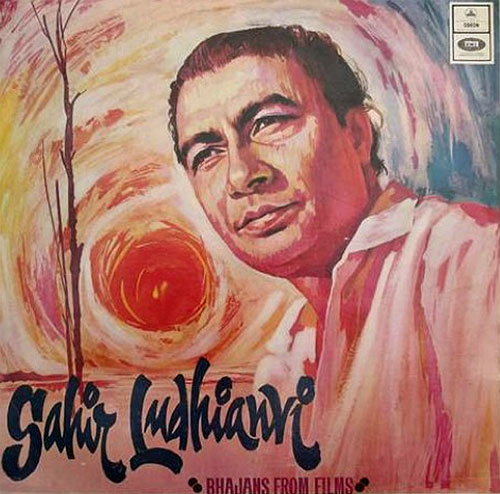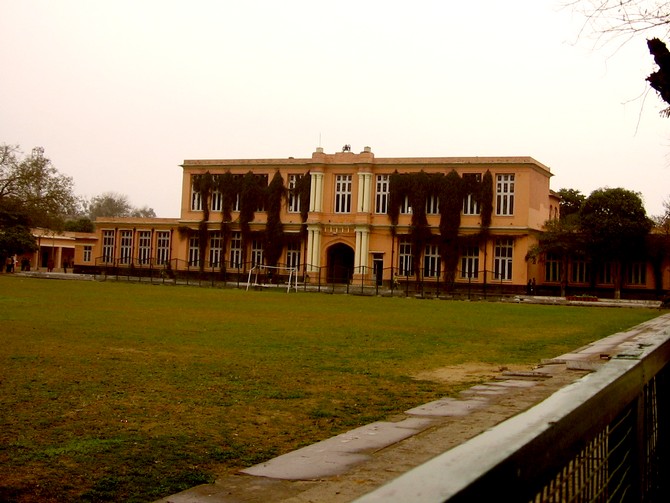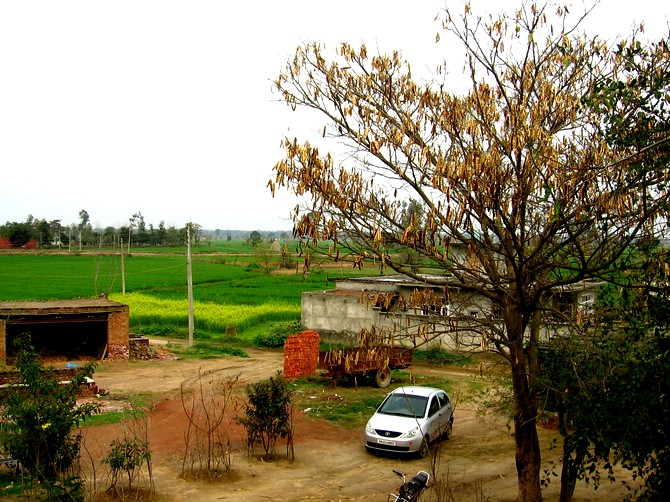 | « Back to article | Print this article |
1406 km through Punjab: In the city of the magician
We've been carrying Deepak Kirpalani's Punjab travelogue.(Read part one here) We begin from where Kriplani left us last -- in freezing cold in 'the city of the magician'. This is part two of the travelogue
Read part one here: Five Days and 1406 km through Punjab
Part three here: Finding bliss in Amritsar
Part four here: A pilgrimage of another kind
Part five here: Stories of valour and sacrifice
Much has been said about Abdul Hayee (1921-1980) -- popularly known as Sahir Ludhianvi -- arguably the finest lyricist to have written for Hindi films.
A traumatic childhood followed by a resentful youth left him bitter, vulnerable, moody, difficult and deeply scarred for life. By his own admission, he poured all the bitterness he experienced into his poetry.
Duniya ne tajurbaat-o-hawadis ki shakl mein
Jo kuch mujhe diya hai, wo lauta raha hoon main
His disillusionment with an unjust society finds expression in Ye duniya agar mil bhi jaye to kya hai! (Pyaasa, 1957).
No song expresses the exploitation of women better than Aurat ne janam diya mardon ko (Sadhana, 1958) and Man re tu kahe na dheer dhare (Chitralekha, 1964) is the ultimate ode to the futility of love and life.
In a medium where every other song deploys cliched phrases to express mushy romance, his words carry the force of a sledgehammer.
He was equally at home composing inspiring verse such as Tadbeer se bigdi hui taqdeer bana le (Baazi, 1951), Ye desh hai veer jawanon ka (Naya Daur, 1957), Tu Hindu banega na Musalman banega (Dhool Ka Phool, 1959) and Na munh chupa ke jiyo (Hamraaz, 1967). Main zindagi ka saath nibhata chala gaya (Hum Dono, 1961) is the most concise version of the Bhagwad Gita. Consider these couplets written using the structure of the ghazal:
Main zindagi ka saath nibhata chala gaya
Har fikr ko dhuen mein udata chala gaya
Barbadiyon ka sog manana fuzool tha
Barbadiyon ka jashn manata chala gaya
Jo mil gaya usi ko muqaddar samajh liya
Jo kho gaya main usko bhulata chala gaya
Gham aur khushi mein farq na mehsoos ho jahan
Main dil ko us maqaam pe laata chala gaya
Given his temperament and the pride he took in his poetry, it comes as no surprise that he fell out with heavyweights such as SD Burman, OP Nayyar and Lata Mangeshkar. Equally, he fought for the right of the lyricist to be credited for the creation of the song. Until he took up the cause, the names of the composer and the singer alone were announced before a song was played on the radio.
1406 km through Punjab: In the city of the magician
It is said that Abdul Hayee never adapted himself to Hindi cinema; it was the other way around. For quite a few of his poems were later used as lyrics, Ye kuche, ye neelamghar dilkashi ke (Pyaasa, 1957), Kabhi kabhi mere dil mein khayal aata hai (Kabhi Kabhie, 1976) and the perfect antidote for broken relationships, Chalo ik baar phir se ajnabi ban jaen hum dono (Gumraah, 1963) being among them.
In his biography, Yash Chopra reveals that the character of Amitabh Bachchan in Kabhi Kabhie was modelled on the poet-lyricist.
The concluding line of the mother-of-all Hindi film qawwalis: Na to caravan ki talash hai/Ye ishq ishq hai ishq ishq (Barsaat Ki Raat, 1960) underscores his genius.
Khaak ko but, but ko devta karta hai ishq
Inteha ye hai ke bande ko Khuda karta hai ishq
It is love/faith that transforms clay into an idol, which in turn symbolises divinity. At its greatest fervour, it unites man with God.
Abdul Hayee knew his poetic worth.
No wonder he chose for himself, the literary name Sahir (magician) Ludhianvi.
Sahir never married. He would have been 90 on March 8.
Long before the Punjab trip was conceived, I knew that I had to be in Sahir's hometown some day. To be where he had been and to see what he had seen. Ludhiana was the halt for the first night, never mind if it entailed travelling nearly twice as much on day one as on day two.
Did the wizard know that I would look for him years after he was gone?
In recent years I have been privileged to know him better through a senior colleague and friend, who knew him as a fellow poet and friend.
I can almost picture him -- towering frame, tentative body language, pock-marked face, wry smile -- break into a verse of his own, by way of an answer.
Tera mujhse hai pehle ka naata koi
Yoon hi nahin dil lubhata koi
Jaane tu ya jaane na
Maane tu ya maane na
(Aa Gale Lag Ja, 1973)
1406 km through Punjab: In the city of the magician
Ludhiana's welcome was so frosty that we hit the bed without a regular meal (only buttered toast and coffee), without brushing our teeth or changing! We weren't complaining. It was a part of the experience. It was fun! The next morning was almost as cold with a slight drizzle and a grey sky, but became more comfortable as the day progressed.
We set out in search of Sahir at the Government College for Boys in downtown Ludhiana. The story goes that he was rusticated from the college for sitting on the lawns/holding hands with a girl.
We had coffee and walked around the campus spread over an area sprawling enough to accommodate a score of Mumbai's colleges with a football field thrown in. The cold weather and overcast conditions added to the atmosphere. It wasn't Sahir's fault, really! And he exacted his revenge.
The college now accepts female students for higher classes. And ironically, the street past the main entrance is officially named after it most famous rusticated student
Mumbai casts its spell far and wide. More than once during our travel, as part of the security procedure, we were questioned about our city of origin.
Eyes twinkle, faces light up and resistance melts on hearing the magic word. The security guards at the college extended an invitation to visit again as we made our way out past them.
1406 km through Punjab: In the city of the magician
Our next stop was the Museum of Rural Life of Punjab on the campus of Punjab Agricultural University. We were there 40 years to the day the foundation stone had been laid (March 1, 1971). If you thought the college campus was extensive, this one could have taken in half a dozen of them with room to spare.
It reminded me of the US. With so much open space and natural beauty all around, I wonder how many students have been rusticated from here!
We spent close to an hour looking for Sahir's house in the busy Karimpura area, north of the railway station. No one knew and we weren't sure either. For the map shows another Karimpura to the west. Half a century and more has gone by and we called off the search with gajrela (piping hot carrot halwa) and flavoured milk with crushed dry fruit. It takes steely resolve to stay away from food in Punjab. Enriched with fat, fortified with calories and utterly irresistible!
1406 km through Punjab: In the city of the magician
For once, India's bravest have been honoured at the War Museum aptly named after Ranjit Singh, the powerful and just ruler of Punjab in the first half of the 19th century.
If his statue at the entrance is anything to go by, his presence must have put the fear of God in the deadliest adversary. It is said he had greater foresight with one good eye than most endowed with two good ones. On being asked about the damaged eye by Lord Auckland, Governor-General of India, Fakir Azizuddin, the Foreign Minister at the court of Ranjit Singh replied: The Maharaja is like the sun which has only one eye. The splendour and luminosity of his single eye is such that I have never dared to look at his other eye. The Governor-General was so pleased with the reply that he gifted the minister his gold watch.
The central hall has an impressive artwork of Ranjit Singh, his able general Hari Singh Nalwa and others contemplating matters of state. Hari Singh Nalwa, the scourge of the Pashtuns, has been described as the noblest and gallant of the Sikh generals of his time, the very embodiment of honour, chivalry and courage. If the name still doesn't ring a bell, think of the patriotic number Mere desh ki dharti (Upkar, 1967).
Ye bagh hai Gautam Nanak ka, khilte hain aman ke phool yahan
Gandhi, Subhash, Tagore, Tilak, aise hain chaman ke phool yahan
Rang hara Hari Singh Nalwe se, rang lal hai Lal Bahadur se
Rang bana basanti Bhagat Singh, rang aman ka veer Jawahar se
The artwork is flanked by portraits of Field Marshalls Cariappa and Manekshaw. To the left are portraits of Punjabi Chiefs of Staff. It was here, as I turned my attention to the right, that I came across Flying Officer Nirmal Jit Singh Sekhon, 18 Squadron 10877 F(P), Indian Air Force, 39 years after reading about his deeds of valour in the 1971 war with Pakistan. I knew all about him.
Some memories never die. They remain in the deep recesses of the mind and spring to consciousness at an appropriate moment, which can be as rare as once in a lifetime.
Nirmal Jit Singh Sekhon's (born 1943) was the first in a line of portraits of recipients of the Param Vir Chakra on the right wall.
Quoting from his citation for the highest military honour: On 14 December 1971, Srinagar Airfield was attacked by a wave of six enemy Sabre aircraft. Flying Officer Sekhon was on readiness duty at the time. However, he could not take off at once because of the clouds of dust raised by another aircraft which had just taken off. By the time the runway was fit for take-off, no fewer than six enemy aircraft were overhead, and strafing of the airfield was in progress.
Nevertheless, in spite of the mortal danger of attempting to take off during an attack, and in spite of the odds against him. Flying Officer Sekhon took off and immediately engaged a pair of the attacking Sabres. In the fight that followed, at tree top height, he all but held his own, but was eventually overcome by sheer weight of numbers.
His aircraft crashed and he was killed. In thus sacrificing himself for the defence of Srinagar, Flying Officer Sekhon achieved his object, for the enemy aircraft fled from the scene of the battle without pressing home their attack against the town and the airfield. The sublime heroism, supreme gallantry, flying skill and determination, above and beyond the call of duty, displayed by Flying Officer Sekhon in the face of certain death, set new heights to Air Force traditions.
In 63 years since Independence, the Param Vir Chakra has been conferred no more than 21 times, 14 posthumously, and only once to a member of the Indian Air Force. If that wasn't rousing enough, a few minutes later a retired military officer led us to a room where the chalk blue turban the war hero wore during his sortie, lay in a glass cabinet. I knew all about Nirmal Jit Singh Sekhon. Today, he had commanded me to his presence.
1406 km through Punjab: In the city of the magician
Ludhiana gets its name from Lodhi-ana, the dwelling of the Lodis, the dynasty that ruled from Delhi from 1451 until the first battle of Panipat in 1526. We never found the Lodi fort we looked for. Instead, we came across a rest house (sarai) that became Ranjit Singh's fort and currently is a training centre for the Punjab Police Academy in Phillaur, close to the river Satluj. It was off limits to civilians that day but one of the officers was kind enough to show us around.
NH 1 runs straight as a bullet for miles on end. The landscape from Delhi to the border tends to be monotonous. Flat-as-a-carom board terrain, fields of wheat and mustard, eucalyptus trees, mist in the distance and grey skies. The soil is much like sand at a beach. Construction is unplanned and uninspiring. Rather ugly, actually. Which really is the case with most of India. What stops us from building well-designed structures? Without exception, construction along the highway is a good 20-25 feet away from the road. It is my hypothesis that it is so for security reasons. To allow unhindered passage to military vehicles in times of war. We moved on after a stop at Phagwara.
1406 km through Punjab: In the city of the magician
Rarely have I seen an idol of the Mother Goddess as radiant and resplendent as the one at the Devi Talaab temple that evening. One of the key destinations in Jallandar, it gets its name from the pool in which it is located. One could almost feel the positive energy that emanated from it. Running behind schedule for the second day in a row, we now headed for the town to which all roads in Punjab lead.
Crossing the river Beas, we entered what technically was a part of the Macedonian empire in 326 BC. The river marked the eastern limit of Alexander's conquests across Asia. Home sick and battle weary, Alexander's troops refused to march further. Closer to our time, scholar, philosopher and President S Radharishnan welcomed King Paul of Greece on a state visit with the remark that he was the first Greek head of state to come to India duly invited.
You never like some places no matter how often you visit them. Others grow on you. And with a few, it is love at first sight. City lights, busy markets and an electric atmosphere greeted us as we descended the ramp leading down from the elevated section of the highway. We knew this was a place we were going to like. We had arrived at what the Urdu poets would have described as our manzil-e-maqsood (the ultimate destination). It took a while for realisation to sink in. We were actually there. A narrow street was all that separated our hotel from the Golden Temple.






